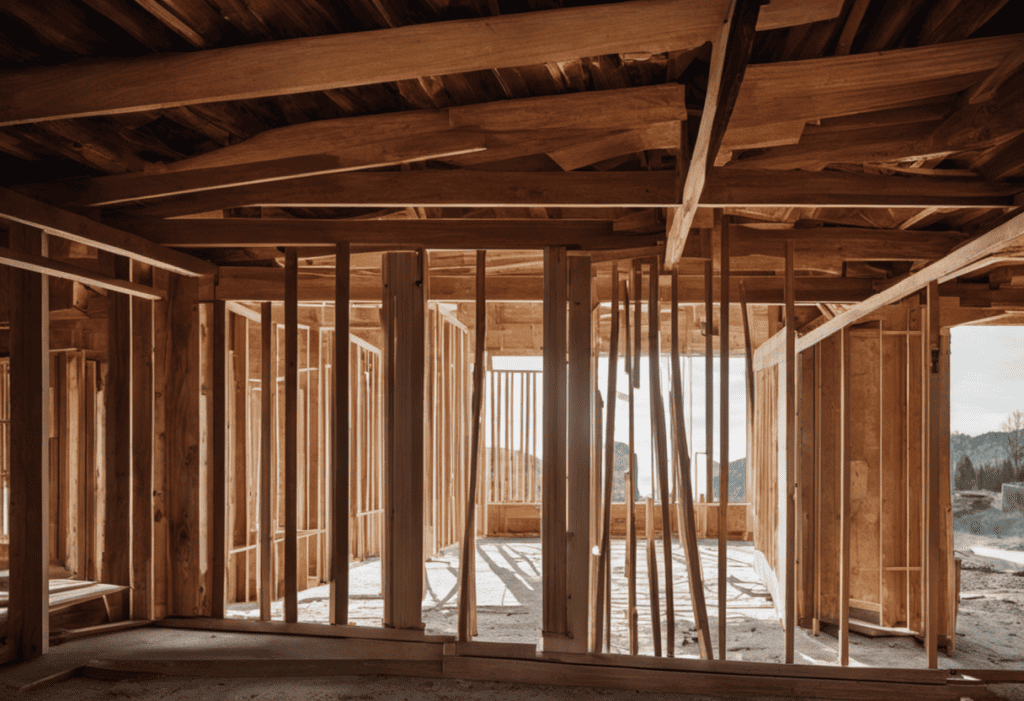
Image showcasing a close-up view of a load-bearing door frame under construction, with sturdy wooden beams firmly attached to the surrounding walls, emphasizing the importance of a solid foundation
As a homeowner, I’ve always wondered about the actual functionality of load-bearing door frames. Are they simply for aesthetics, or do they play a crucial role in supporting the weight of doors and maintaining the structure’s integrity?
This article will dive deep into the secrets of load-bearing door frames. By unlocking their mysteries, we will uncover the truth and provide valuable insights for making informed decisions about the safety and stability of your home.
Let’s explore together and discover the truth about load-bearing door frames.
Key Takeaways
- Door frames are typically not load-bearing but can handle a limited amount of added weight.
- Solid materials like timber, aluminium, and composite can support the door’s weight and enhance the doorway’s aesthetics.
- Building a load-bearing door frame requires proper engineering, design, and adherence to building codes and regulations.
- Load-bearing doors require careful design, construction, and consideration of materials and hardware to ensure proper support and maintain structural stability.
The Basics: Understanding Load-Bearing Door Frames
I’ve learned that understanding the load-bearing capacity of door frames is crucial when it comes to ensuring the structural integrity of a building. Door frames can be categorized into two types: load-bearing and non-load-bearing frames.
Load-bearing frames are designed to carry the door’s weight and distribute it evenly throughout the structure. They’re typically made of solid materials like timber, aluminium, or composite, which can handle heavier loads.
On the other hand, non-load-bearing frames aren’t designed to support any additional weight and are usually made of lighter materials. Load distribution in door frames is important to prevent any undue stress on the frame, which could lead to structural issues.
Load-Bearing Capacity: What You Need to Know
I can’t stress enough the importance of understanding the load-bearing capacity of door frames and how it can affect the structural stability of a building. It’s crucial to dispel common misconceptions and provide proper maintenance and care for load-bearing door frames. Here are the key points to consider:
- Load bearing capacity:
- Door frames aren’t usually load-bearing, but they can handle a limited amount of added weight.
- Materials like timber, aluminium, and composite can enhance the doorway’s aesthetics and support the door’s weight.
- Weaker or low-quality materials may break under heavy loads.
- Common misconceptions:
- Door frames are primarily designed to support the door, not heavy loads.
- Building a load-bearing door frame requires proper engineering, design, and adherence to building codes.
- Maintenance and care:
- Regular inspection and maintenance of load-bearing door frames are necessary to ensure structural integrity.
- Proper installation of load-bearing doors in a load-bearing wall is essential to prevent structural damage.
Understanding the load-bearing capacity of door frames and providing appropriate maintenance and care are vital for maintaining the structural stability of a building.
Building a Strong Foundation: Creating Load-Bearing Door Frames
Creating load-bearing door frames requires careful engineering and design to ensure a strong foundation. The load-bearing door frame design supports the door’s weight and maintains structural integrity. To achieve this, load-bearing door frame construction techniques must be employed.
A well-designed load-bearing door frame should have a horizontal beam with adequate structural strength to distribute the load vertically. Additionally, the head and sides of the door frame should be designed to carry the entire load. Proper engineering and adherence to building codes and regulations are essential to create a load-bearing door frame that can withstand the required load.
Exploring Load-Bearing Doors: Function and Importance
As a construction professional, I understand the function and importance of load-bearing doors in distributing weight and maintaining structural stability. Load-bearing door frame construction techniques are crucial for ensuring these doors’ proper support and durability.
When comparing load-bearing doors to non-load-bearing doors, several key differences emerge.
Load Bearing Doors:
- Designed to support significant weight and distribute it effectively.
- Requires careful engineering and construction to ensure structural integrity.
- Play a crucial role in maintaining the stability of a building.
Non-Load Bearing Doors:
- Primarily designed for aesthetic purposes and ease of access.
- They don’t have the same weight-bearing capacity as load-bearing doors.
- It can be constructed with lighter materials, such as hollow-core frames.
Understanding these distinctions is essential for selecting the appropriate door type based on a structure’s specific requirements and load-bearing capacity. Proper load-bearing door frame construction techniques are vital for ensuring safety and longevity in any construction project.
Installation Dos and Don’ts: Load-Bearing Doors in Walls
Installing load-bearing doors in walls requires careful attention to structural details, such as reinforcing the frame and ensuring proper alignment.
When it comes to installation techniques, common mistakes should be avoided to ensure the door’s load-bearing capacity and the overall structural integrity of the wall.
One common mistake is neglecting to reinforce the door frame adequately. This can result in the structure being unable to support the door’s weight, leading to sagging or even collapse.
Another mistake is improper alignment, which can cause the door to bind or not close properly.
Following proper installation guidelines, including using appropriate reinforcement materials, ensuring correct measurements, and consulting experts if needed is essential to avoid these issues.
Materials and Hardware: Choosing the Right Components for Load-Bearing Doors
When selecting the appropriate materials and hardware for my load-bearing doors, I carefully consider the load-bearing capacity.
When it comes to choosing hardware for load-bearing doors, there are several factors to consider:
- Strength and durability: The hardware should withstand the weight and pressure on the door.
- Size and compatibility: The hardware should be the right size and compatible with the chosen materials and door design.
- Proper installation: The hardware should be installed correctly to support the load effectively.
In terms of proper materials for load-bearing doors, the following considerations are important:
- Strength and stability: The materials should have sufficient strength to bear and maintain the door’s weight.
- Resistance to deformation: The materials should be able to resist deformation under heavy loads.
- Longevity: The materials should be durable and resistant to wear and tear.
Expert Insights: Unlocking the Secrets of Load-Bearing Door Frames
I’ve learned from the experts that understanding the secrets behind load-bearing door frames is essential for ensuring structural integrity.
Regarding door frame materials, choosing solid options like timber, aluminium, or composite is crucial, as weaker or low-quality materials may break under heavy loads.
Load-bearing door installation techniques are also important to consider. The frame should support the door’s weight, with screws providing additional support. A thicker rim and an additional hinge in the centre may be necessary for heavy doors.
Building a load-bearing door frame requires proper engineering and design, following building codes and regulations.
Load-bearing doors play a crucial role in distributing weight and maintaining structural stability, so their load-bearing capacity should be considered when choosing materials and hardware.
Additionally, when installing doors in a load-bearing wall, accurate measurements and knowledge of the wall’s structure are essential, and it’s recommended to have an expert involved in the installation process.
Frequently Asked Questions
Can Load-Bearing Door Frames Be Made From Materials Other Than Timber, Aluminum, and Composite?
Can load-bearing door frames be made from materials other than timber, aluminium, and composite? What are the advantages and disadvantages of different materials for load-bearing door frames?
Are Any Specific Building Codes or Regulations Govern the Construction of Load-Bearing Door Frames?
Building codes and regulations dictate the construction of load-bearing door frames. Specific requirements must be followed to ensure structural integrity and safety. Compliance with these regulations is crucial for proper installation and support.
How Do Load-Bearing Doors Distribute Weight and Maintain Structural Stability?
Load-bearing doors act like pillars in a building, distributing weight and maintaining structural stability. Proper construction techniques, like using a solid load-bearing door frame, and regular maintenance and repair ensure their effectiveness.
What Are the Potential Risks and Consequences of Improperly Installing a Door in a Load-Bearing Wall?
Improperly installing a door in a load-bearing wall can have potential dangers and consequences. It may compromise the wall’s structural integrity, leading to instability and damage to the overall structure.
Are Any Specialized Tools or Techniques Required for the Installation of Load-Bearing Doors in Walls?
Are any specialized tools or techniques required to install load-bearing doors in walls? Technical courses for load-bearing door installation include accurately measuring and understanding the wall’s structure, while tools required may consist of a structural header and proper lumber for support.
Can Door Reinforcement Plates Help with Load-Bearing Door Frames?
Yes, fortify home door reinforcement plates can definitely help with load-bearing door frames. By installing these plates, you can distribute the weight of the door more evenly and reinforce the area around the door jamb, making it more resistant to forced entry and damage.
Great Frames
Unlocking the secrets of load-bearing door frames has shed light on their crucial role in maintaining the structural integrity of our homes.
These frames aren’t merely decorative but rather essential components that support the weight of doors and contribute to the overall stability of the building.
By understanding the intricacies of load-bearing door frames, we can make informed decisions to ensure the safety and longevity of our homes.
Let’s embrace this newfound knowledge and fortify our homes with confidence and peace of mind.

Hi, I’m George Anderson, an expert installer with an extensive door installation and maintenance background. I’m passionate about sharing my knowledge on door equipment and accessories through my writing, helping homeowners make informed decisions. My specialty lies in custom door installations, with a commitment to enhancing the aesthetics of every home. Please feel free to reach out anytime for help with door-related questions or needs.

